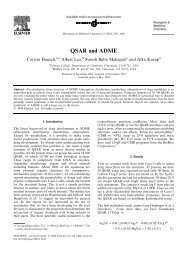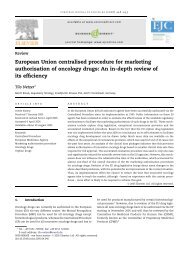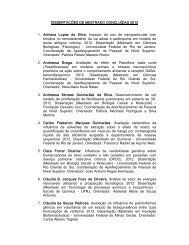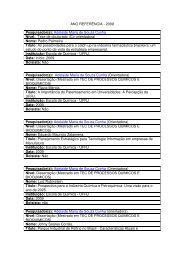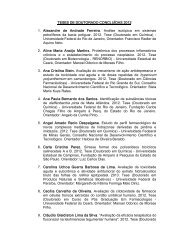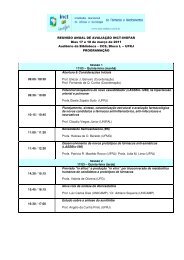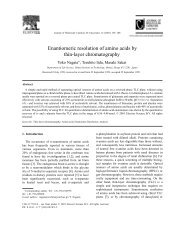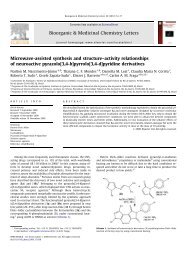Novel Functionalyzed 5-Aryl-2-furfuril-N-acylhydrazone Derivatives ...
Novel Functionalyzed 5-Aryl-2-furfuril-N-acylhydrazone Derivatives ...
Novel Functionalyzed 5-Aryl-2-furfuril-N-acylhydrazone Derivatives ...
You also want an ePaper? Increase the reach of your titles
YUMPU automatically turns print PDFs into web optimized ePapers that Google loves.
CONFIDENTIAL<br />
INCT-INOFAR Project: <strong>Novel</strong> <strong>Functionalyzed</strong> 5-<strong>Aryl</strong>-2-<strong>furfuril</strong>-N-<strong>acylhydrazone</strong> <strong>Derivatives</strong><br />
with Potent Antiinflammatory and Analgesic Activities: LASSBio-1609 e LASSBio-1636<br />
Coordinator: Carlos A. Manssour Fraga, LASSBio, Institute of Biomedical Sciences, UFRJ<br />
The diversity of mechanisms involved in the genesis of neuropathic pain makes especially<br />
difficult the treatment of this disease, as well as the variable response of patients the same therapy,<br />
the many adverse effects and interactions with other drugs. A very important point is that only<br />
about a half of patients are able to obtain sufficient pain relief with currently available drugs<br />
(Rogers et al., 2006).<br />
For this reason, the main objective of this project is to synthesize and evaluate<br />
pharmacologically novel furfuryl-N-<strong>acylhydrazone</strong> derivatives, designed by applying the azavinylogation<br />
strategy on furfuramide derivatives described by Kort and co-workers (2008) as<br />
blockers of the Nav 1.8 sodium channels, highlighting the compound A-803467, a selective blocker<br />
of these channels (Figure 1).<br />
A 3D-QSAR (CoMFA) model for the Nav 1.8 sodium channel was created to assist the<br />
structural planning of the new family of furfuryl-N-<strong>acylhydrazone</strong> derivatives. This model is the<br />
only 3D-QSAR model for a subtype of sodium channel described to date (Figure 1).<br />
Cl<br />
O<br />
A-803467<br />
O<br />
N<br />
H<br />
OCH 3<br />
OCH 3<br />
Ar 1<br />
O<br />
O<br />
N<br />
H<br />
Aza-vinylogy<br />
N<br />
R<br />
Figure 1: Design concept of novel furfuryl-NAH derivatives.<br />
Ar 2<br />
The synthetic methodology employed for obtaining of the novel N-<strong>acylhydrazone</strong><br />
compounds consisted in four steps, all of them presenting high yields, involving reactions such as<br />
Suzuki coupling, Yamada oxidation, hydrazinolysis and condensation (Scheme 1). In some steps,<br />
procedure optimizations were made, through microwave reactions, in order to improve reaction<br />
time and yield. All compounds of the new family of furfuryl-N-<strong>acylhydrazone</strong> derivatives were<br />
obtained as a single diastereomer and 1D NOESY experiments carried out suggest that the relative<br />
configuration presented by these derivatives is the E configuration. Elemental analysis, infrared and<br />
mass spectra were also made, complementing the structural characterization of the new NAH<br />
derivatives.<br />
Scheme 1: Reagents and conditions: a) K 2 CO 3 , PdCl 2 [P(Ph) 3 ] 2 , i-PrOH/H 2 O, 80°C, MW; b) KOH,<br />
I 2 , MeOH, 0°C; c) NH 2 NH 2 .H 2 O, EtOH, rt; d) ArCHO, EtOH, HCl cat , rt or ArCO(CH 3 ), MW, 80°C.
CONFIDENTIAL<br />
Among these new N-<strong>acylhydrazone</strong> derivatives the compounds LASSBio-1609 and<br />
LASSBio-1636, can be identified as authentic analgesic prototypes, as both showed improved<br />
antinociceptive activity profile in animal models of inflammatory and neuropathic pain. These<br />
derivatives were capable of decreasing the hipernociception induced by carrageenan and CFA in<br />
mice at 30 and 100 µM concentration, showing a profile very similar to those showed by prototype<br />
A-803467. Also, oral administration of compounds LASSBio-1609 and LASSBio-1636 produced<br />
anti-allodynic and anti-hyperalgesic effects in rats in the Chung model (L5/L6 Spinal Nerve<br />
Ligation - SNL) of neuropathic pain. These effects were comparable to those of the prototype A-<br />
803467 in the same model (Figure 2). In addition, these derivatives proved to have high stability in<br />
rat plasma, featuring, at least partially, an adequate bioavailability profile.<br />
Figure 2: Antinociceptive effect of LASSBio-1609, LASSBio-1636 and A-803467 in SNL<br />
neurophatic pain model in rats. (A) Thermic hypersensibility; (B) Mechanical allodynia.<br />
The novel NAH derivatives LASSBio-1609 and LASSBio1636 did not affected the motor<br />
coordination of mice as observed in the rota-rod test. Additionally, it is important to highlight that<br />
the compounds only interfered with the threshold of nociception in the mice where inflammation<br />
was induced, bringing it back to normal. However, in control mice, the compounds did not affected<br />
the normal threshold for activation of pain. These results demonstrate that these prototypes act only<br />
in the disease level, not affecting the normal physiological functions.<br />
In an attempt to identify the specific molecular mechanism of action of LASSBio-1609 and<br />
LASSBio-1636, electrophysiological (whole-cell patch-clamp technique) in vitro assay was<br />
employed. As a source of NaV1.8 currents (the primary target of NAH derivatives) dorsal root<br />
ganglion cultured neurons were used. To ensure that the NAH compounds are probably acting on<br />
Nav1.8 TTX-R currents, TTX (100 nM) were added to the perfusion solution. It was observed that<br />
even in the presence of TTX, there is a remaining current that is probably composed of Nav1.8 plus<br />
Nav 1.9. The perfusion of cell with LASSBio-1636 (10 µM) reduced TTX-resistant currents. It is<br />
noteworthy that the effect of LASSBio-1636 was washed out suggesting a surmountable effect. This<br />
preliminary result is in line with the hypothesis that LASSBio-1636 is probably a Nav1.8 selective<br />
blocker.<br />
References:<br />
- Kim, Sh; Chung, Jm (1992) An experimental model for peripheral neuropathy produced by<br />
segmental spinal nerve ligation in the rat. Pain 50: 355-363.<br />
- Kort, M. E. et al. (2008) Discovery and biological evaluation of 5-aryl-2-furfuramides, potent<br />
and selective blockers of the Nav1.8 sodium channel with efficacy in models of neuropathic and<br />
inflammatory pain. J. Med. Chem. 51: 407-416.<br />
- Rogers M. et al. (2006) The role of sodium channels in neuropathic pain. Semin. Cell. Dev. Biol.<br />
17:571-581.




